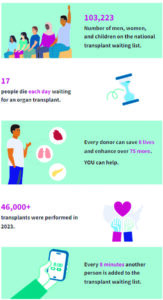
Preliminary data from the Organ Procurement and Transplantation Network (OPTN) indicates that the United States witnessed a continued rise in organ donors throughout 2023, resulting in several record-breaking trends in the organ transplantation system. This upward trend in annual donations led to notable milestones in organ donation, procurement, and transplant activities.
In 2023, a total of 16,335 individuals generously donated one or more organs upon death. This marks a significant 9.6 per cent increase compared to 2022 and signifies the first year with more than 15,000 deceased donors.
Additionally, 6,953 individuals became living organ donors, representing the third-highest annual total and the highest since the record set in 2019. Despite annual fluctuations in the number of living donors, 2023 marks the thirteenth consecutive year of growth in deceased organ donors nationwide.
“We are gratefully indebted to the generosity of all donors – living and deceased – and donor families, to continue to allow us to help yet more people in need of a transplant,” said Dianne LaPointe Rudow, DNP, president of the OPTN Board of Directors. “At the same time, the community of organ donation and transplant professionals continues to pursue improvements to perform even more lifesaving transplants with the organs that are available.”
Transplant trends
In 2023, a total of 46,632 organ transplants were conducted, encompassing contributions from both living and deceased donors. This figure reflects an 8.7 per cent increase from 2022 and a substantial 12.7 per cent increase from 2021, which marked the inaugural year with over 40,000 organ transplants.
Of these transplants, 39,679 were facilitated by deceased donors, indicating an 8.9 per cent surge compared to 2022. Notably, this milestone marks the eleventh consecutive year of record-setting growth in deceased donor transplants.
Moreover, 6,953 organ transplants were made possible through living organ donors, marking the highest total since 2019 when a record of 7,397 living donor transplants occurred. Although kidney transplants account for over 90 per cent of living donor transplants, the number of living donor liver transplants has been steadily increasing in recent years. In 2023, a record-breaking 658 living donor liver transplants were performed, showcasing a noteworthy advancement in the field.
Kidney disease disproportionately affects Black and Hispanic populations, making them significant segments of kidney transplant candidates. In 2023, the number of transplants for both Black and Hispanic individuals increased across all organ types.
Notably, for the first time, over 10,000 organ transplant recipients were Black, and non-Hispanic, totalling 10,824 across all organ types, with 8,323 specifically for kidney transplants. This represents a notable 12.3 per cent increase in total transplants for Black, non-Hispanic recipients compared to 2022.
Similarly, for the first time, more than 8,500 transplants were conducted for Hispanic/Latino recipients, comprising 8,540 across all organ types, with 5,407 dedicated to kidney transplants. This marks a significant 6.5 per cent increase in total transplants for Hispanic/Latino recipients compared to the previous year.
In a groundbreaking milestone, 2023 witnessed the performance of over 10,000 liver transplants for the first time in history. A total of 10,660 liver transplants were conducted, marking an impressive 11.9 per cent increase compared to 2022 and sustaining an eleven-year trend of annual record-setting achievements.
Furthermore, lung transplants surpassed the 3,000 mark for the first time, reaching a total of 3,026 procedures. Notably, all-time volume records were also established for kidney transplants, totalling 27,329, and heart transplants, amounting to 4,545 procedures. These remarkable achievements underscore the continuous advancements and growing capacity within the organ transplantation field.

Deceased donation trends
In a notable shift from previous years, deceased donors increasingly represent non-traditional forms of donation, including circulatory death (as opposed to brain death) and older age. In 2023, 5,896 donors, constituting 36 per cent of the total, donated after circulatory death, reflecting a substantial 40.7 per cent increase over the past three years.
Additionally, 6,884 deceased donors, comprising 42 per cent of the total, were aged 50 or older. The most prevalent age range among deceased donors in 2023 was 50 to 64, totalling 5,393 donors, reflecting a notable increase of 16 per cent compared to 2022. These trends highlight a changing landscape in deceased organ donation practices, with a growing emphasis on alternative donation methods and donors from older age groups.
Living donation trends
While living organ donors typically skew younger compared to deceased donors, there’s a noticeable rise in the proportion of older living donors. In 2023, the most common age range among living donors was between 35 and 49, with 2,720 individuals falling within this category, marking a 7.9 per cent increase from 2022.
Moreover, there were 2,495 living donors aged 50 or older in 2023, reflecting a higher rate of increase at 12.1 per cent compared to the 35-49 age group. The third most prevalent age group among living donors consisted of individuals aged 18 to 34, with 1,736 donors in 2023.
Despite being the third most common age group, this segment experienced a marginal increase of only 1.1 per cent compared to 2022. These trends underscore a notable shift in the demographics of living organ donors towards older age groups.















